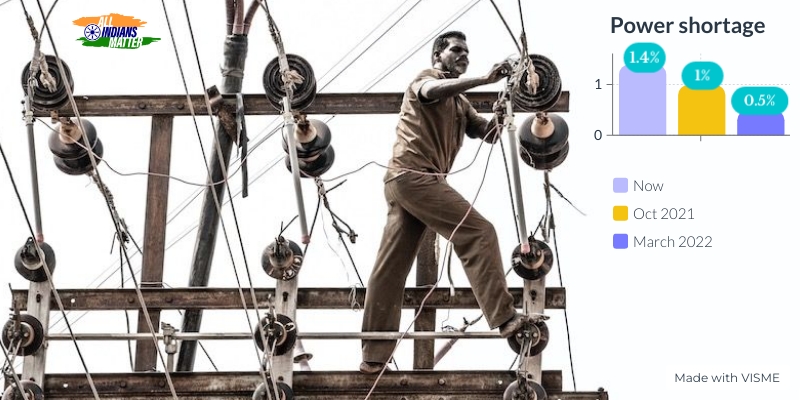Ashraf Engineer
April 23, 2022
Hello and welcome to All Indians Matter. I am Ashraf Engineer.
It’s hot and it could get a lot more uncomfortable. That’s because India is likely to experience more power cuts this year as electricity generation companies’ coal inventories are at their lowest pre-summer levels in nine years. This at a time when electricity demand is expected to rise the fastest in 38 years. India faces a crippling power shortage over the summer months as the load from air conditioners and refrigeration overwhelms generation.
SIGNATURE TUNE
The power grid clocked a record load of 200,570 megawatts on July 7 last year at the height of summer. This year, since mid-March, the grid has routinely recorded maximum loads of 195,000 MW, including a peak of 199,584 MW on April 8 – which is less than 0.5% below the record. This is made worse by the fact that there is no solar power available during the evening peak hours.
India is facing very high loads much earlier in the year this time around and the power grid is struggling to keep up. As a result, the grid’s frequency has faltered regularly since mid-March with longer periods below the safe operating range. This is called ‘under-frequency’ – a sign that the grid cannot meet the demand – and it makes power cuts more likely. Such cuts could stifle industrial activity at a time when the economy is struggling to recover from the COVID-19 pandemic and unemployment is at a record high. Andhra Pradesh, for example, home to large automobile and pharmaceutical plants, is facing a power deficit of 8.7%. As a result, manufacturers are reducing output – some by up to 50%.
How much higher is the demand at the national level? The electricity shortage shot up to 1.4% a couple of weeks ago, according to a Reuters analysis of government data, which is significantly higher than the 1% deficit in October last year when India faced a serious coal shortage, and the 0.5% shortfall in March this year.
Power plants had average coal inventories of nine days on April 1, the lowest since 2014. The government recommends that the plants maintain 24 days’ coal stocks but inventories have not recovered since falling to a low of just four days last September. Then, too, there were widespread power cuts.
The industrialised states of Gujarat and Maharashtra have now resorted to power cuts and Jharkhand, Bihar, Haryana and Uttarakhand are reporting power shortages of over 3% each.
Coal accounts for three-fourths of India’s power generation and dwindling stocks make it unlikely that generation can be ramped up quickly to meet demand.
There are logistical issues too. There is a shortage of trains to transport coal to power plants – the Indian Railways has committed 415 per day for these deliveries at a time when the utilities require 453. But the actual number of trains available from April 1 to 6 was 379 per day, 16% fewer than needed.
Climate change has made its presence felt with the early arrival of hot weather. Temperatures are likely to keep rising till June-end or early July, which means electricity demand will also keep rising.
Total power output is likely to rise 15.2% during the current financial year. This means that coal-fired power generation would go up by 17.6%. This demand has already forced India to cut coal supplies to the non-power sector, despite a record output by Coal India Ltd, which produces 80% of India’s coal. Now, Coal India is targeting a 4.6% increase in supply to utilities to 565 million tons this financial year to avert a shortage.
But coal supply still won’t suffice, so the power ministry has asked utilities to import more coal and blend it with Indian coal. This is problematic because it would add to the financial challenges of power distributors since global coal prices are way higher than the average levels of last year due to Russia’s invasion of Ukraine.
For you, all this probably means a long, hot summer.
Thank you all for listening. Please visit allindiansmatter.in for more columns and audio podcasts. You can follow me on Twitter at @AshrafEngineer and @AllIndiansCount. Search for the All Indians Matter page on Facebook. On Instagram, the handle is @AllIndiansMatter. Email me at editor@www.allindiansmatter.in. Catch you again soon.






